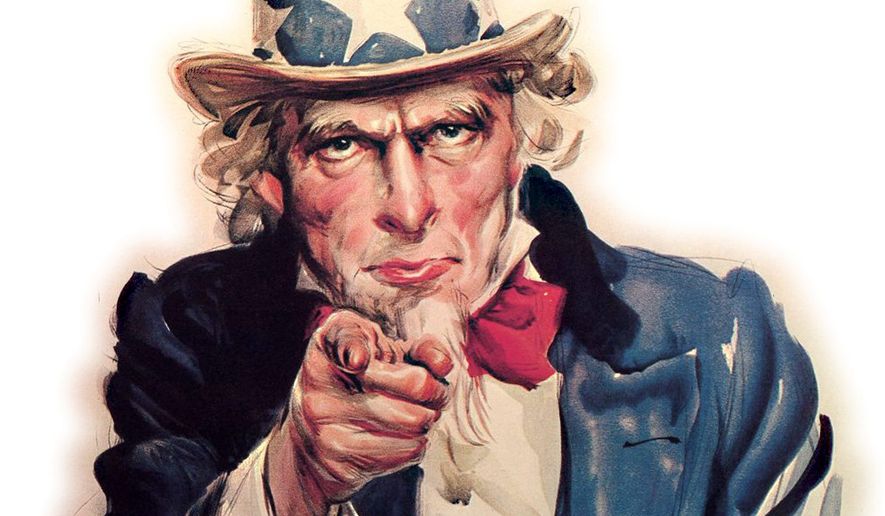OPINION:
No tribute was more moving after Americans witnessed the horror of Sept. 11, 2001, than Queen Elizabeth II breaking tradition two days later by having the Star-Spangled Banner played at the changing of the guard at Buckingham Palace before a crowd of some 5,000 tearful Americans.
Of course, Americans recognize that the national anthem was born in the War of 1812 with the Brits, but what may not be known is that confrontation between the two powers also gave rise to another popular symbol for the nation, namely, Uncle Sam.
To be sure, the story about Uncle Sam isn’t nearly as riveting as that of Francis Scott Key, held prisoner by the British as he watched his enemies unsuccessfully shelling Ft. McHenry in Baltimore’s harbor, leading to his writing of the verse. But it is uniquely American in terms of its emotion.
The tale begins with two brothers, Samuel and older brother Ebenezer Wilson, who in 1789 left their parents’ farm in Massachusetts to seek their fortunes in Troy, New York, near Albany. They set up a meatpacking industry dubbed E. and S. Wilson, as well as other retail food businesses.
Samuel married Betsy Mann in 1797, had children and was also blessed with numerous members of his own family and his wife’s. Thanks to his many nieces and nephews and his genial nature to all, he was usually referenced as Uncle Sam, a title that also became his calling card for Troy’s townspeople.
When the War of 1812 broke out, the secretary of war through contractors recognized that adequate supplies of food had to be available for American troops. One contractor, Edward Anderson Jr. of New York City, advertised for 5,000 barrels of beef and pork to be ready by April, 1813. And the Wilson brothers answered the call.
Their barrels of meat were stamped with the initials, “E.A. — U.S.” The E.A. stood for the main contractor, Edward Anderson, and the U.S. for the United States. Of course, town folk weren’t aware of this translation, but when the workmen for the Wilson brothers were queried about it, they were certain that the U.S. stood for their caring and dear employer, Uncle Sam Wilson.
Somehow as weeks and months passed, the “U.S.” noted on government supplies were being referenced as Uncle Sam, simply a warmer synonym for United States.
Not surprisingly, beginning with the Troy, N.Y. Post newspaper in September 1813, the symbol was not only recognized but slowly spread across the country and through time. Artists rendered their own rendition of what Uncle Sam looked like, but they varied enormously.
But none took on the imprimatur of Sam Wilson, the meatpacker, who prospered as a businessman with some 200 workers on his payroll at two New York state locations. In fact, Wilson was popular only as a Troy citizen and passed away without national notice in July 1854, although now the town calls itself “The Home of Uncle Sam.”
Uncle Sam was ingrained by the era of the Civil War, but without a uniform face. That came with illustrator, Thomas J. Nast (1840-1902), who in magazines in the late-19th century also gave rise to the current image of Santa Claus.
On Nov. 20, 1869, in Harper’s Weekly magazine, Nast portrayed “Uncle Sam’s Thanksgiving Dinner.” But it was a rather common Uncle Sam, middle-aged, dressed in traditional clothes of the era, a bit stout and with a goatee that was almost inconspicuous.
Then came artist James Montgomery Flagg (1877-1960), who gave the nation the Uncle Sam that is well-known today: tall and thin in stature, white-bearded, with a top hat, blue jacket and, of course, the striped trousers.
That Uncle Sam has sustained the nation in time of crises is well-known, first illustrated during World War I, with the “I want you” recruiting poster. And in the midst of the Cold War on Sept. 15, 1961, the symbol was made secure, with Congress saluting “Uncle Sam Wilson of Troy, New York, as the progenitor of America’s National Symbol of Uncle Sam.”
But Congress wasn’t finished in giving Uncle Sam Wilson recognition. During the administration of President George H.W. Bush, it passed a resolution, on the bicentennial of the town of Troy, recognizing Wilson’s birthday as “Uncle Sam Day.” And President Bush embellished that resolution with a proclamation that noted the treasured legacy of the nation:
“During Sam Wilson’s lifetime, Americans won our country’s independence; formed a system of self-government under our great Constitution; explored and settled the frontier; and raised the hopes of freedom-loving peoples around the world.”
And Sam Wilson’s birthday is September 13 — just two days after the tragedy of the twin towers attacks.
• Thomas V. DiBacco is professor emeritus at American University.




Please read our comment policy before commenting.